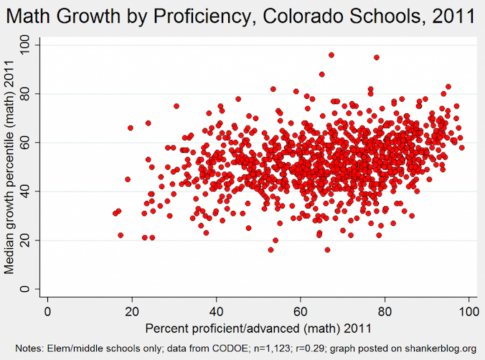Note: This post originally appeared on Urban Wire.

Secretary of Education nominee Betsy DeVos and Minnesota Senator Al Franken sparred at Tuesday’s confirmation hearing over whether student performance is best measured by proficiency or growth. How this question is resolved over the next year will have enormous consequences for which schools are identified as low performers in need of intervention.
The question highlighted by Senator Franken is whether schools should be judged by how well their students perform on state tests—often relative to an arbitrary “proficiency” threshold—or by the average growth students make from one year to the next. Senator Franken made the case for growth, arguing that a metric of proficiency encourages teachers to ignore those students likely to fall far below or above the threshold.
But the problems with using proficiency to assess school performance go beyond those created by an arbitrary threshold. Measuring average student performance reflects not only how much students are learning at school but also the knowledge they brought when they enrolled. Growth measures go a long way toward correcting for that by examining the progress students make while enrolled at a given school.
This debate is not just theoretical; it makes an enormous difference in practice because of how prominently test scores factor in how states identify failing schools. Because of the well-documented correlation between test scores and students’ socioeconomic status and race, judging schools based on their average test scores will tend to penalize schools that serve large numbers of lower-income and racial minority students, even if those schools produce significant student growth on math and reading tests.
Using student-level data from two states, Harvard Professor Martin West and I found that 40 to 60 percent of schools serving mostly low-income or underrepresented minority students would fall into the bottom 15 percent of schools statewide based on their average test scores, but only 15 to 25 percent of these same schools would be classified as low performing based on their test-score growth.
Leaning too heavily on proficiency rates or average test scores can unfairly target schools, especially those that serve disadvantaged students, for intervention, while ignoring schools where students are learning the least. The consequences can be significant: schools identified as persistently low performing can be taken over by the state, forced to fire their principal, or turned into a charter school.
When the federal government first required states to administer annual math and reading tests as part of the No Child Left Behind Act (NCLB), it was not possible to calculate growth measures in all states. But NCLB, by requiring regular tests, soon made such progress-based measures feasible.
The Every Student Succeeds Act, NCLB’s successor, provides states with much greater discretion in how they measure school performance, including in the relative importance assigned to proficiency versus growth measures. The evidence makes clear that growth measures should receive significant weight if schools are to be judged based on how well they serve students rather than on which students they serve.
—Matthew M. Chingos
Matthew M. Chingos is a Senior Fellow at the Urban Institute.






